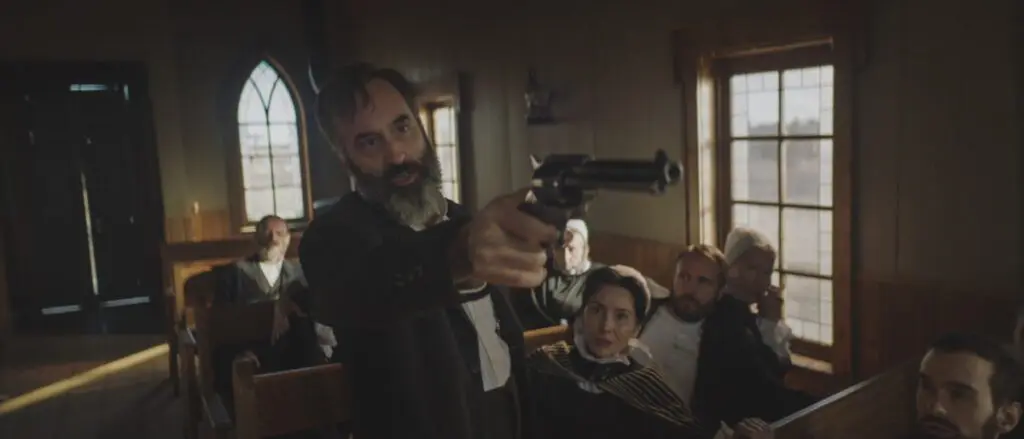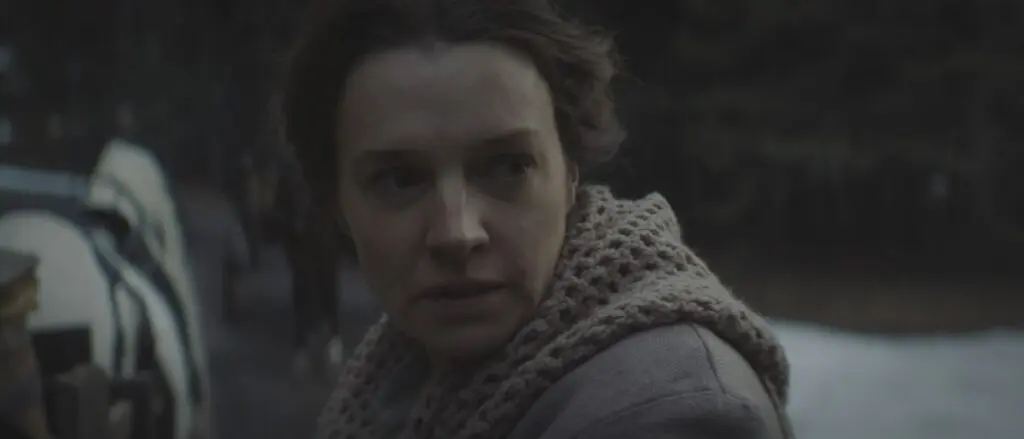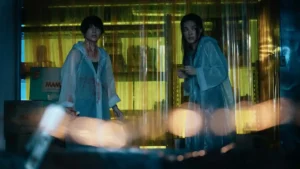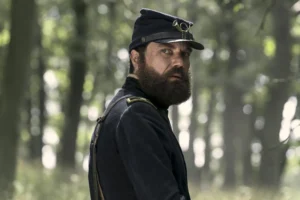Summary
Canadian Folk horror about an outcast woman suspected of witchcraft and her daughter. Set in 1973, but doesn’t look like it. Wonderful cast and atmosphere, but real issues with the writing.
Religion and distrust are the staple ingredients of The Curse of Audrey Earnshaw, written and directed by Thomas Robert Lee (Empyrean). There’s more to it than that, of course, but how much more may depend on your interpretation of the film when you watch it. Personally, I struggled with interpretation; more later.
The Curse of Audrey Earnshaw is set in 1973, in a rural community in Alberta, Canada which has deliberately rejected wider society and technological progress, making everything look as though it is a century or two earlier. The introductory text tells us that the farms have been struggling, with sick animals and poor harvests, which has been going on since an eclipse seventeen years earlier. Also during the eclipse, a somewhat outcast Agatha Earnshaw (Catherine Walker, A Dark Song) gave birth to a daughter but has kept her secret ever since. Agatha has the only thriving farm in the area, which naturally enough arouses suspicion. The story of the film itself starts when Agatha’s daughter Audrey (Jessica Reynolds, My Left Nut) spies the unfriendly attitude her mother receives from the villagers and decides she’s had enough of both their abuse and being kept secret by her mother.
It may be an odd little community, with some miserable and stuffy characters, but the acting is excellent throughout. Walker demonstrates the sense of sacrifice that comes with motherhood like she really means it, prepared to put up with all manner of compromises and weakened status for the sake of her daughter’s protection. Reynolds is beguiling to both the men who encounter her and the viewer, but – like Carrie, perhaps – has a tricky line to tread between potent and immature. The secondary role which stood out to me was the tragic Bridget Dwyer (Hannah Emily Anderson, utterly different to her What Keeps You Alive role), who we see go clearly mad; but whether this is due to an actual curse, her family circumstances, or everyone around her is not clear to me (though a scene near the end justifies her decline).
These characters are intriguing, and their cast gives out sincere and clear emotions with every scene, but often their rationale is not clear, at least to me. I’m not clear whether the farmers blame the eclipse and witches for their misfortune, or blame witches for causing the eclipse, or if it is just a fluke of the land they settled on and the eclipse gave them an easy explanation. Sometimes it is difficult to tell whether the witchcraft on display is a metaphor for Audrey’s growing frustration and teenage angst, or if it is genuinely taking place; is she really cursing people, or does she just believe she is, so strongly that the belief spreads? There are brief scenes when it is obvious but so brief that it can be a confusing change, and it’s easy to wonder if what you saw was really happening. Often I’m comfortable with a film leaving questions open, but not this time, I’m afraid.

I have a couple of other issues with a lack of clarity in the writing. There is a gradual lead up to a revelation about Audrey’s origin, I did not understand it at all when it finally is talked about. I couldn’t even work out whether I had missed something in the speech or whether there was (deliberate?) ambiguity again. Very puzzling, but I don’t know if it was supposed to be. Maybe it will be covered better in a director’s cut of The Curse of Audrey Earnshaw. The other baffling element of the writing was the period: I have no idea why Lee set the film in 1973. There was no benefit or even plot relevance to the year, just a couple of quirky and momentary anachronisms. It’s not as though this settlement was modern Amish, like in Witness; or has its context explained neatly, like in The Village.
That said, the setting is a beautifully realized one, and it is easy to forget that there are cities, televisions, and pop music elsewhere in the land. The buildings, the farms, the clothing, and even the coven that meets a little way out all look like they have been left somewhere out of time; and there is a painful dilemma for those residents who want to stay that way when times are tough, and they know it might be possible to obtain aid from outside. This deliberate isolation does contribute to the eerie atmosphere, along with the absence of smiles or music in the village, and the unpredictable nature of everyone’s behavior. The Curse of Audrey Earnshaw is largely set in autumn, and the rustic hues bring out an atmosphere of dying nature and dwindling livelihood, aided by Nick Thomas’s sharp cinematography. Oh, I’d advise against watching this film if you are at all sensitive about harm to animals, where his camerawork can be just as effective.
But what was The Curse of Audrey Earnshaw really about? Ever since the seventeenth-century witch trials, society’s treatment of people accused of witchcraft has been considered the epitome of misogyny. Yet in this film, Audrey’s hissy-fits do seem to result in deaths, madness, and malformed animals. So is Lee suggesting that were actually bad, rather than misunderstood, after all? The way the Earnshaws (and their white-robed friends) live a little way out from the village as pariahs, suggests the film’s theme is perhaps about how people treat “others” with suspicion; especially those who have been nurtured in religion. Perhaps he is saying that people with utterly opposing beliefs will never be quite tolerant of each other. What I saw most clearly was a demonstration of the fragility of a parent-child relationship – the longer Agatha kept Audrey to herself, the more she craved independence – but something tells me this was not the intended theme of the film.
Believe it or not, I enjoyed The Curse of Audrey Earnshaw, for its cast and its visual style. The weird ambiguities spoiled that, though, and left me wondering what I was supposed to take away from it.




